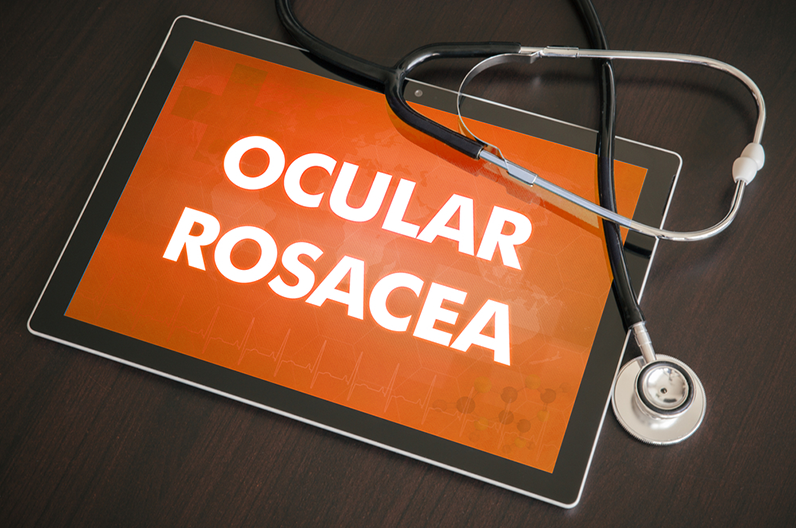(I-MED Pharma)
Dry eye is often a chronic disease that can cause patients to experience both discomforting physical symptoms as well as mental distress, thereby affecting many day-to-day activities and reducing quality of life. There are many risk factors for the development or worsening of dry eye, including in some cases, other diseases. In this blog, we are going to look at how rosacea – a prevalent skin condition – can affect the eyes, how it can be a risk factor for dry eye disease, as well as how to manage discomforting ocular symptoms.
What is Ocular Rosacea?
Rosacea is a skin disease that primarily affects the central facial skin such as the cheeks, chin, nose, and central forehead, but can also affect the eyes, which is called ocular rosacea. Scientific reviews report approximately 58 to 72% of rosacea patients experience ocular symptoms,[1],[2] about one-third of patients develop potentially sight-threatening corneal involvement,[1] and that this under-appreciated condition can cause permanent blindness if inadequately treated.[3]
What are Common Ocular Rosacea Triggers?
Rosacea is usually chronic and progresses over time, but symptoms typically show periods of exacerbation and remission which can be triggered by exposure to certain factors.[1] Triggers can be specific to each individual, but some examples can include sun exposure, spicy foods, extreme temperatures, physical exercise, menopause, and emotional distress such as anger and embarrassment.[1] This disease most commonly affects middle-aged adults (roughly between the ages 30 to 60).
What are the Symptoms?
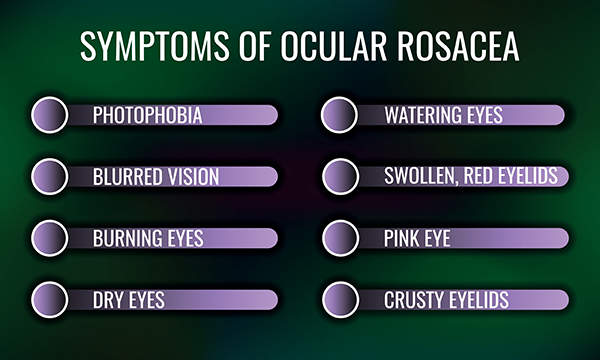
An inflammatory disease, common rosacea symptoms include reddening of the skin (erythema), facial flushing, papules (small, raised, solid bumps or pimples) and pustules (pimples that contain pus). When rosacea involves the eyes, ocular rosacea causes eyelid and ocular surface inflammation, and can include signs and symptoms of blepharitis, Meibomian gland dysfunction, and recurrent chalazia, and patients can experience red or watery eyes, foreign body sensation, dryness, itching, light sensitivity (photophobia), and blurred vision. [1],[4]
Ocular rosacea symptoms can be mild to severe, and sometimes ocular symptoms can be the first sign of the rosacea disease in patients, preceding skin signs and symptoms.[2] Early diagnosis and proper treatment and management are important, as this condition can cause permanent blindness if untreated.[1]
Ocular Rosacea & Dry Eye
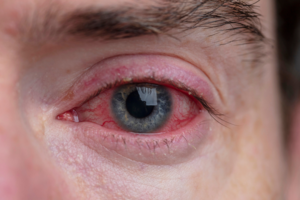
Ocular rosacea causes inflammation of the eyelids and ocular surface which can also affect the Meibomian glands, leading to dry eye disease.[2] If left untreated, ocular rosacea can cause visual impairment through severe dry eye and corneal ulcers and scarring.[4] Besides dry eye disease, common findings in ocular rosacea patients include other ocular surface disorders such as Demodex, Meibomian gland dysfunction (MGD), and blepharitis, which are discussed further below.
Ocular Rosacea & Demodex
Demodex is a common microscopic parasite that live in the eyelids and eyelashes. It is normal to find these eight-legged mites in the sebaceous glands and hair follicles of healthy people, but they can quickly become a problem when there is an increased density of mite infestation. A Demodex infestation is associated with bacterial load and mite allergens,[2] and may act as vectors for other microorganisms.[1]
It has been found that Demodex density is increased in the skin, eyelids, and eyelashes of rosacea patients.[3] It is also further suggested that these mites may play an important role in the inflammation process of rosacea and can further aggravate the development of ocular surface disease.[2]
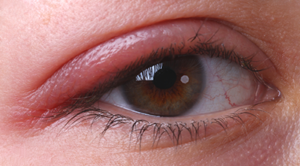
Ocular Rosacea & MGD, Chalazia, and Blepharitis
Along with Demodex, blepharitis and Meibomian gland dysfunction are common findings in ocular rosacea patients, and recurring chalazia are also usually observed in these patients as a consequence of MGD.[1] Because MGD affects the quality and quantity of the tear film by altering the lipid layer (which is one of the three layers that make up the tear film), dry eye, mainly the evaporative type, is present in a large number of patients with rosacea.[4]
What are the Best Treatments for Ocular Rosacea?
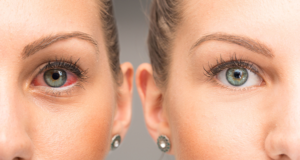
While the precise cause of rosacea is not known, it is important to see an eye care professional for diagnosis and to start treatment to prevent worsening of symptoms and damage to the ocular surface to avoid severe damage and even permanent blindness. Early diagnosis and rosacea treatment can help slow the progress of inflammation, which is why regular eye exams are important for maintaining your eye health.
Symptom management options for ocular rosacea can include avoiding triggering factors to reduce exacerbating periods of the disease.[1] Other management options include using warm compresses, such as the I-RELIEF™ HOT & COLD THERAPY EYE MASK for the relief of symptoms associated with blepharitis, dry eye disease, MGD, styes and chalazia. This can be followed with lid hygiene using the I-LID ’N LASH® line of ocular cleansers, which includes I-LID ’N LASH® PLUS with 5% tea tree oil for deeper cleaning. These cleansers are effective yet gentle, cleaning the eyelids and lashes by removing ocular debris and reducing bioburden, and when used along with lubricating eye drops, help break the dry eye cycle and aid in the restoration of corneal health.
Preservative-free and viscoadaptive artificial tears, such as those found in the I-DROP® line, quickly and effectively relieve dry eye symptoms by providing superior hydration and lubrication to the cornea for enhanced patient comfort. In addition to viscoadaptive hyaluronan, I-DROP® MGD contains superior osmoprotectants and bioprotectants to stabilize and enhance the lipid layer, offering unmatched hydration for patients suffering from evaporative dry eye symptoms. For severe dry eye, lubricating overnight eye ointments can be used, such as I-DEFENCE®, which moisturizes and protects the ocular surface while you sleep.
Nutrition is an important factor in both your overall and ocular health. Eating omega-3 fatty acids, either regularly in your diet or through daily supplements, has been shown to improve the quality of Meibomian gland secretion.[1] I-VU® OMEGA-3 PLUS, a highly purified and concentrated omega-3 supplement in capsule form, and I-VU® OMEGA-3, an omega-3 liquid supplement that contains GLA and vitamin D3, both provide the most important omega-3s in the re-esterified triglyceride form (rTG) for better absorption.
Intense pulsed light (IPL) therapy, which is used widely in dermatology to treat a variety of skin conditions, can also be used to help improve dry eye symptoms caused by MGD and rosacea and may potentially reduce bacteria and parasitic growth associated with Demodex infestation.[5] While IPL was not designed specifically for periocular application but for dermatological, a new generation of IPL device, the E>EYE with IRPL® (Intense Regulated Pulsed Light) technology was developed as a long-lasting treatment for dry eye disease. To see a comparison between IRPL® technology and conventional IPLs, look at this convenient table.
While an ocular rosacea diagnosis may be difficult to receive, regular eye examinations from an eye care professional, proper treatment, and a good eye care routine can all help to control discomforting signs and symptoms. The mental health impact of a chronic ocular condition should also be addressed.
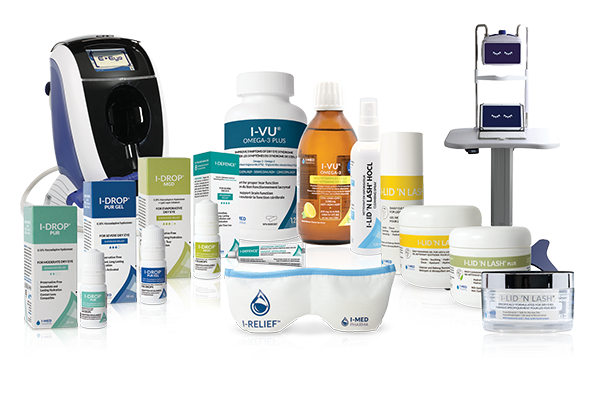
[1] Vieira, Höfling-Lima, A. L., & Mannis, M. J. (2012). “Ocular Rosacea–A Review.” Arquivos Brasileiros de Oftalmologia, 75(5), 363–369. https://doi.org/10.1590/S0004-27492012000500016
[2] Barbosa EB, Tavares CM, Silva DFL, Santos LS, França AFEC, Alves M. (2022). “Characterization of Meibomian Gland Dysfunction in Patients with Rosacea.” Arq. Bras. Oftalmol. 2019;82:1-7. https://doi.org/10.5935/0004-2749.20230043
[3] Redd, & Seitzman, G. D. (2020). “Ocular Rosacea.” Current Opinion in Ophthalmology, 31(6), 503–507. https://doi.org/10.1097/ICU.0000000000000706
[4] Palamar, M. , Degirmenci, C. , Ertam, I. & Yagci, A. (2015). “Evaluation of Dry Eye and Meibomian Gland Dysfunction With Meibography in Patients With Rosacea.” Cornea, 34 (5), 497-499. doi: 10.1097/ICO.0000000000000393.
[5] Vora, & Gupta, P. K. (2015). “Intense Pulsed Light Therapy for the Treatment of Evaporative Dry Eye Disease.” Current Opinion in Ophthalmology, 26(4), 314–318. https://doi.org/10.1097/ICU.0000000000000166

